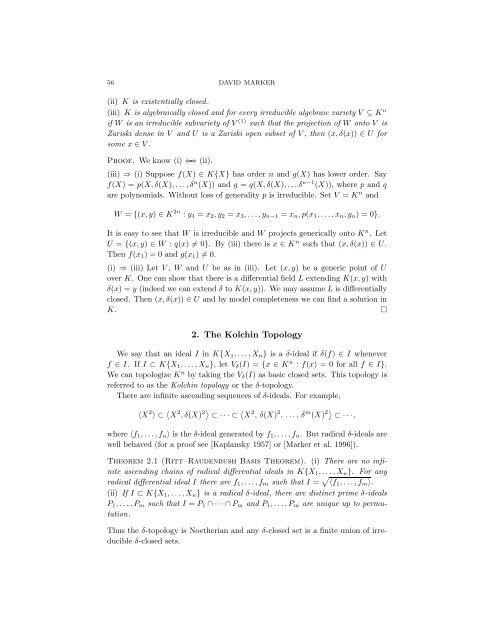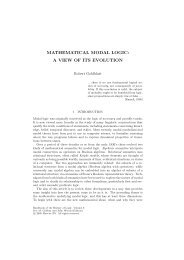Model Theory of Differential Fields
Model Theory of Differential Fields
Model Theory of Differential Fields
You also want an ePaper? Increase the reach of your titles
YUMPU automatically turns print PDFs into web optimized ePapers that Google loves.
56 DAVID MARKER(ii) K is existentially closed.(iii) K is algebraically closed and for every irreducible algebraic variety V ⊆ K nif W is an irreducible subvariety <strong>of</strong> V (1) such that the projection <strong>of</strong> W onto V isZariski dense in V and U is a Zariski open subset <strong>of</strong> V , then (x, δ(x)) ∈ U forsome x ∈ V .Pro<strong>of</strong>. We know (i) ⇐⇒ (ii).(iii) ⇒ (i) Suppose f(X) ∈ K{X} has order n and g(X) has lower order. Sayf(X) = p(X, δ(X), . . . , δ n (X)) and g = q(X, δ(X), . . . δ n−1 (X)), where p and qare polynomials. Without loss <strong>of</strong> generality p is irreducible. Set V = K n andW = {(x, y) ∈ K 2n : y 1 = x 2 , y 2 = x 3 , . . . , y n−1 = x n , p(x 1 , . . . , x n , y n ) = 0}.It is easy to see that W is irreducible and W projects generically onto K n . LetU = {(x, y) ∈ W : q(x) ≠ 0}. By (iii) there is x ∈ K n such that (x, δ(x)) ∈ U.Then f(x 1 ) = 0 and g(x 1 ) ≠ 0.(i) ⇒ (iii) Let V , W and U be as in (iii). Let (x, y) be a generic point <strong>of</strong> Uover K. One can show that there is a differential field L extending K(x, y) withδ(x) = y (indeed we can extend δ to K(x, y)). We may assume L is differentiallyclosed. Then (x, δ(x)) ∈ U and by model completeness we can find a solution inK. □2. The Kolchin TopologyWe say that an ideal I in K{X 1 , . . . , X n } is a δ-ideal if δ(f) ∈ I wheneverf ∈ I. If I ⊂ K{X 1 , . . . , X n }, let V δ (I) = {x ∈ K n : f(x) = 0 for all f ∈ I}.We can topologize K n by taking the V δ (I) as basic closed sets. This topology isreferred to as the Kolchin topology or the δ-topology.There are infinite ascending sequences <strong>of</strong> δ-ideals. For example,〈X 2 〉 ⊂ 〈 X 2 , δ(X) 2〉 ⊂ · · · ⊂ 〈 X 2 , δ(X) 2 , . . . , δ m (X) 2〉 ⊂ · · · ,where 〈f 1 , . . . , f n 〉 is the δ-ideal generated by f 1 , . . . , f n . But radical δ-ideals arewell behaved (for a pro<strong>of</strong> see [Kaplansky 1957] or [Marker et al. 1996]).Theorem 2.1 (Ritt–Raudenbush Basis Theorem). (i) There are no infiniteascending chains <strong>of</strong> radical differential ideals in K{X 1 , . . . , X n }. For anyradical differential ideal I there are f 1 , . . . , f m such that I = √ 〈f 1 , . . . , f m 〉.(ii) If I ⊂ K{X 1 , . . . , X n } is a radical δ-ideal, there are distinct prime δ-idealsP 1 , . . . , P m such that I = P 1 ∩ · · · ∩ P m and P 1 , . . . , P m are unique up to permutation.Thus the δ-topology is Noetherian and any δ-closed set is a finite union <strong>of</strong> irreducibleδ-closed sets.
















